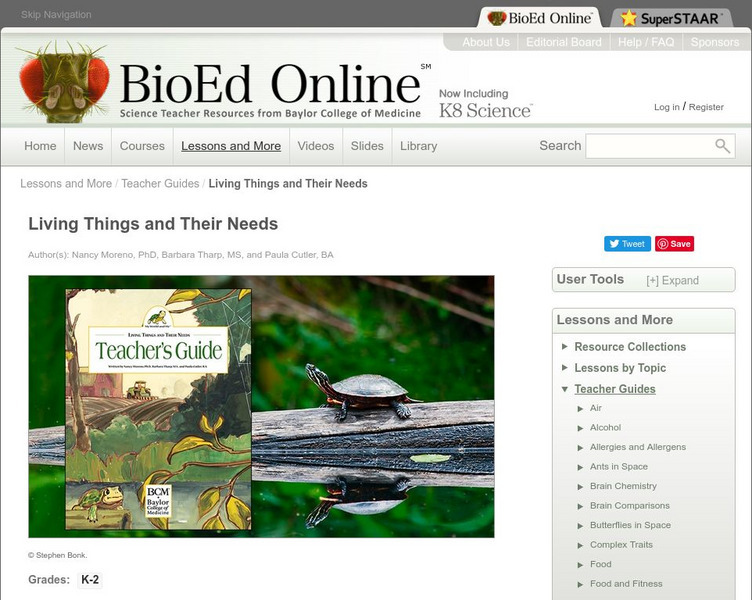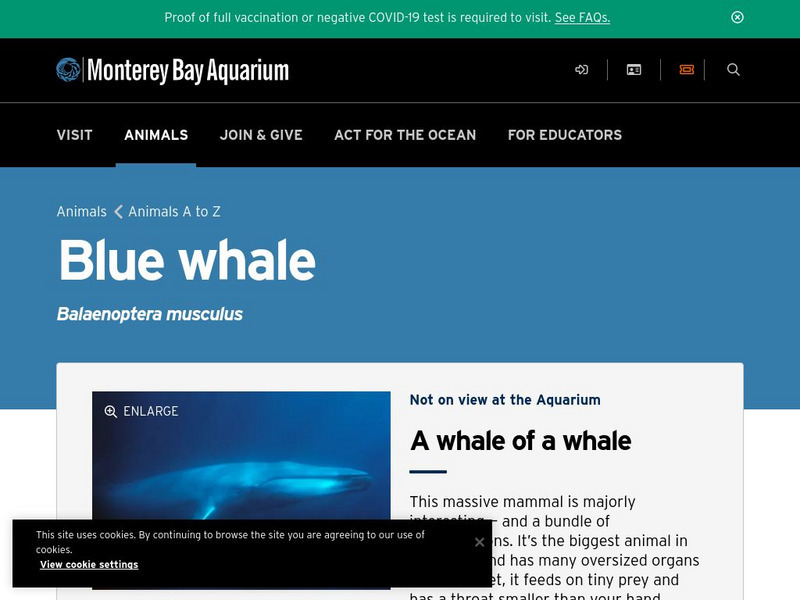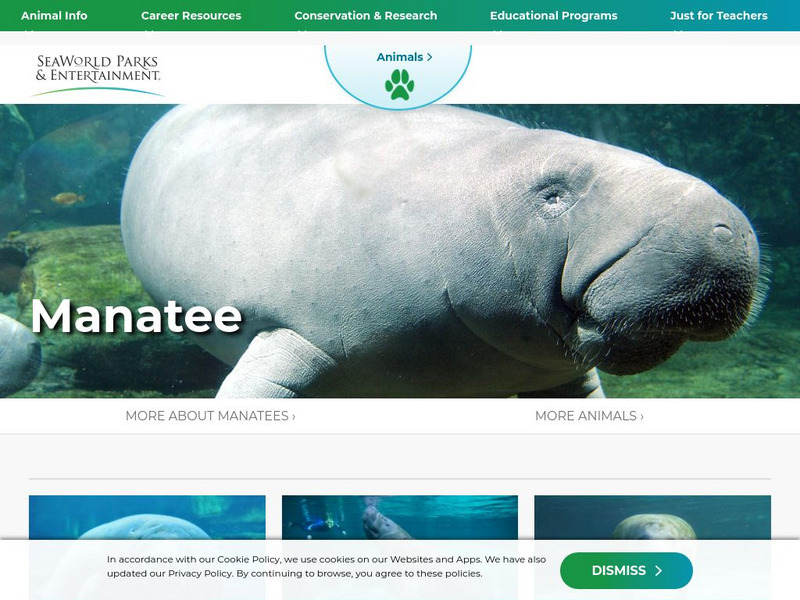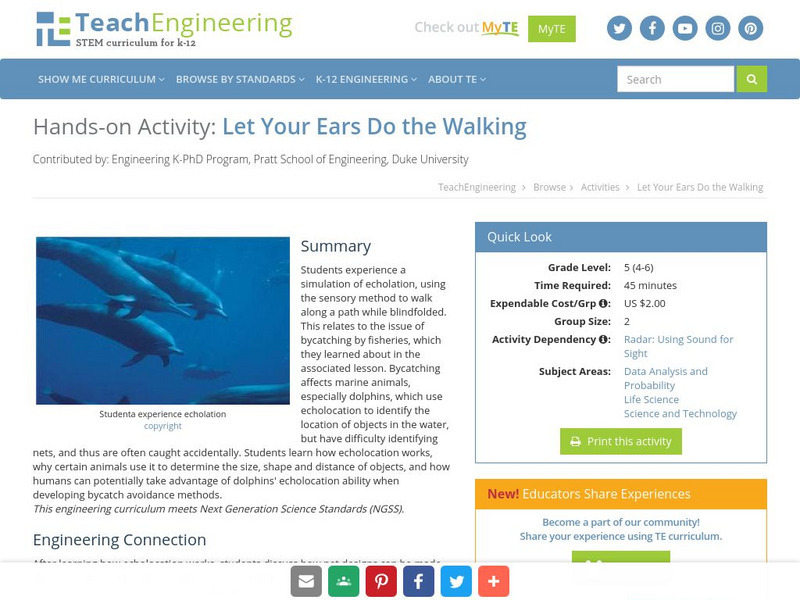Globio
Glossopedia: Seals
Seals are mammals that live parts of their lives on land and other parts entirely in the water. They breed and care for their babies on land, but spend most of their lives in the ocean. This article provides an in-depth look at these...
BioEd Online
Bio Ed Online: Living Things and Their Needs Teacher's Guide
This is a free downloadable teacher's guide (PDF) to teach young children (grades K-2) about living things and their needs.
Monterey Bay Aquarium
Monterey Bay Aquarium: Blue Whale (Balenoptera Musculus)
Resource that gives information on the diet, range, relatives of the blue whale. Conservation notes and cool facts are also included. There are links to similar information on dozens of other types of marine life.
Sea World Parks & Entertainment
Sea World: Beluga Whales
Outlines the characteristics of the beluga whale, including classification, habitat, behaviors, and conservation. Helps students identify with whales with a list of "Books for Young Readers." Information at a level of upper intermediate...
Georgia Department of Education
Ga Virtual Learning: Life and Environment Relationships
In this amazingly comprehensive interactive tutorial you will learn about the characteristics and features of the different biomes on our planet.
Other
Wildlands League
Wildlands League is a registered charity in Ontario, and a chapter of the Canadian Parks and Wilderness Society (CPAWS). It aims to preserve wilderness areas and the biological diversity of lakes, forests, rivers, grasslands and...
Sea World Parks & Entertainment
Sea World: Manatees
Outlines the characteristics of the manatee, including classification, habitat, behaviors, and conservation. Helps students identify with manatees with a list of "Books for Young Readers." Information at a level of upper intermediate or...
PBS
Pbs: River Rewilding: Evaluating Impacts on Ecosystems and Communities
A units that follow a community as they work through Grand River Revitalization Efforts. Investigate how these efforts impacts the social, economic, historic, and biology of the Grand River.
US Geological Survey
Lake Pontchartrain Basin Foundation: Why Worry About Wetland?
Help students understand the functions and values of wetlands through these multiple intelligences learning activities. The site also includes information about the wetland habitats, commercial values, water quality, and erosion control.
TeachEngineering
Teach Engineering: Let Your Ears Do the Walking
In the previous lesson, students learned about the issue of bycatching by fisheries and how it affects marine habitats. Dolphins are one of the main species affected by bycatching. Dolphins use echolocation to identify the location of...
Sea World Parks & Entertainment
Sea World: Baleen Whales
Outlines the characteristics of the baleen whale, including classification, habitat, behaviors, and conservation. Helps students identify whales with a list of "Books for Young Readers." Information at a level of upper intermediate or...
Annenberg Foundation
Annenberg Learner: Journey North: Humpback Whales
A very informative article that answers questions related to characteristics of the humpback whale plus life cycle, ecology, behavioral adaptations and conservation. The migratory patterns of this whale are also tracked.
Annenberg Foundation
Annenberg Learner: Journey North: Right Whales
A comprehensive article that answers a number of questions about the right whale. Questions deal with characteristics, life cycle, ecology and conservation. This site also contains lessons and activities that can be used in the...
Smithsonian Institution
National Museum of Natural History: American Mammals: Marsh Rabbit
Marsh Rabbits live only in marshy areas, and like Swamp Rabbits, are good swimmers. They are often found in habitats with pools of brackish water and plants such as cattails, water hyacinth, rush, centella, and marsh pennywort. Learn...
EL Education
El Education: First Come the Eggs
First Come the Eggs, a picture book for young readers, was created by 3rd grade students in Rochester, New York. This is a biography of Seth Green, the father of fish hatcheries in America. The research included the study of the life...
Smithsonian Institution
National Museum of Natural History: American Mammals: Rock Vole
As suggested by the common name, rocks are a prominent feature in the habitat of this species. Rock Voles prefer forest habitats with moss-covered rocks and boulders, thick ground cover, and accessible water. Learn more about the...
Smithsonian Institution
National Museum of Natural History: American Mammals: Marsh Shrew
Large for a shrew and with velvety dark fur, the Marsh Shrew can be found in marsh, stream, and beach habitats of the coastal rain forest in extreme southwestern Canada and the Pacific Northwest of the United States. This shrew is...
Texas Parks and Wildlife
Texas River Guide
This site discusses Texas rivers and plans for improvement and conservation providing maps.
Other popular searches
- Animals Water Habitats
- Animal Water Habitats
- Land or Water Habitats
- Shallow Water Habitats
- Water Habitats Lesson Plans
- Describe Water Habitats
- Water Habitats Rivers
















